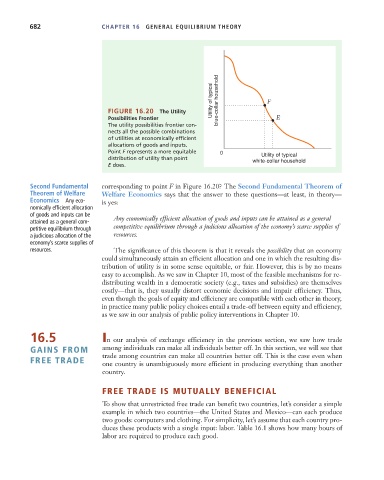Page 708 - Microeconomics, Fourth Edition
P. 708
c16GeneralEquilibriumTheory.qxd 8/16/10 9:14 PM Page 682
682 CHAPTER 16 GENERAL EQUILIBRIUM THEORY
Utility of typical blue-collar household F
FIGURE 16.20 The Utility
Possibilities Frontier E
The utility possibilities frontier con-
nects all the possible combinations
of utilities at economically efficient
allocations of goods and inputs.
Point F represents a more equitable 0 Utility of typical
distribution of utility than point white-collar household
E does.
Second Fundamental corresponding to point F in Figure 16.20? The Second Fundamental Theorem of
Theorem of Welfare Welfare Economics says that the answer to these questions—at least, in theory—
Economics Any eco- is yes:
nomically efficient allocation
of goods and inputs can be
attained as a general com- Any economically efficient allocation of goods and inputs can be attained as a general
petitive equilibrium through competitive equilibrium through a judicious allocation of the economy’s scarce supplies of
a judicious allocation of the resources.
economy’s scarce supplies of
resources. The significance of this theorem is that it reveals the possibility that an economy
could simultaneously attain an efficient allocation and one in which the resulting dis-
tribution of utility is in some sense equitable, or fair. However, this is by no means
easy to accomplish. As we saw in Chapter 10, most of the feasible mechanisms for re-
distributing wealth in a democratic society (e.g., taxes and subsidies) are themselves
costly—that is, they usually distort economic decisions and impair efficiency. Thus,
even though the goals of equity and efficiency are compatible with each other in theory,
in practice many public policy choices entail a trade-off between equity and efficiency,
as we saw in our analysis of public policy interventions in Chapter 10.
16.5 In our analysis of exchange efficiency in the previous section, we saw how trade
GAINS FROM among individuals can make all individuals better off. In this section, we will see that
trade among countries can make all countries better off. This is the case even when
FREE TRADE one country is unambiguously more efficient in producing everything than another
country.
FREE TRADE IS MUTUALLY BENEFICIAL
To show that unrestricted free trade can benefit two countries, let’s consider a simple
example in which two countries—the United States and Mexico—can each produce
two goods: computers and clothing. For simplicity, let’s assume that each country pro-
duces these products with a single input: labor. Table 16.1 shows how many hours of
labor are required to produce each good.

